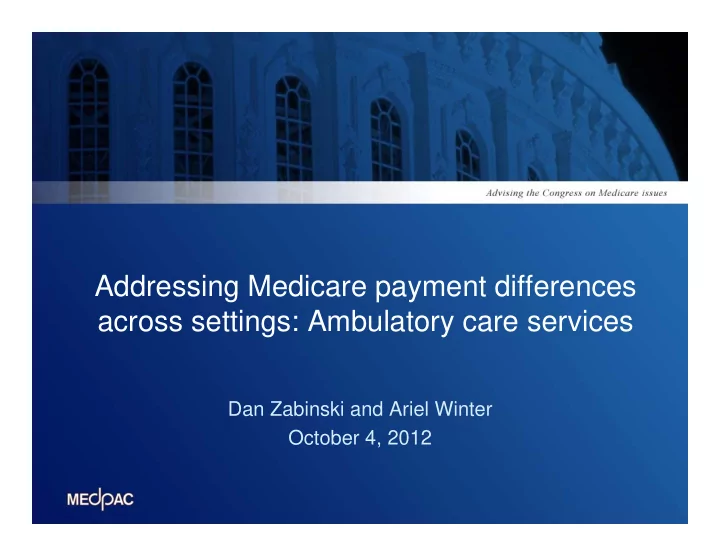

Addressing Medicare payment differences across settings: Ambulatory care services Dan Zabinski and Ariel Winter October 4, 2012
Overview Multiple payment systems for ambulatory services But similar patients receive similar services Payment rates vary across systems for same service E.g., rate for laser eye procedure is 90% higher in outpatient department (OPD) than physician’s office Raises program spending and beneficiary cost sharing 2
Payment principles Patients should have access to settings that provide appropriate level of care Prudent purchaser should not pay more for a service in one setting than another Medicare should base payment rates on resources needed to treat patients in lowest-cost, clinically appropriate setting 3
Reasons why payment rates could differ by ambulatory setting Hospitals incur costs related to standby capacity and emergency care Differences in patient severity that may affect costs Differences in the unit of payment E.g., OPD payment unit includes more ancillaries than physician fee schedule 4
Payment rates for ambulatory services often vary by setting OPD rates often higher than physician office rates Some services are paid same (e.g., MRI, outpatient therapy, clinical lab tests) Shift of services from physicians’ offices to OPDs E.g., share of echocardiograms provided in OPDs grew from 22 percent in 2008 to 25 percent in 2010 Recommendation to equalize rates for non- emergency E&M visits across settings (March 2012) 5
Addressing payment variations for other ambulatory services We have evaluated other ambulatory services that have payment disparities between settings For some services, payments could be equal across settings For other services, payments could be higher in OPDs but the magnitude of the difference could be narrowed 6
Criteria for services that could have equal rates across settings Frequently performed in physicians’ offices (more than 50% of time) Similar unit of payment (ancillaries are less than 5% of total cost of service in outpatient system) Infrequently provided with an ED visit (less than 10%) Minimal difference in patient severity across settings 7
Services that meet potential criteria for equal rates across settings (Group 1) 25 Ambulatory Payment Classifications (APCs) Most are diagnostic tests, such as Level II echocardiogram without contrast Level II extended EEG, sleep, and cardiovascular studies Bone density testing Level II neuropsychological testing Some are procedures, such as laser eye surgery 8
Services for which payment differences could be narrowed (Group 2) 61 APCs Meet 3 of the 4 criteria for equal payments across settings But OPPS has more packaging of ancillaries than does the PFS OPPS rates could be set to Amount needed for equal payments in OPDs and freestanding offices, plus Cost to OPDs for additional packaging of ancillaries 9
Summary of two groups Group 2 (reduce differences) Group 1 (equal payments) > 50% in offices > 50% in offices < 5% packaging > 5% packaging < 10% in EDs < 10% in EDs Similar patient severity Similar patient severity across settings across settings 10
Setting OPPS rates for Group 1 (Example: laser eye procedures) Visit in OPD Visit in Limit on OPPS Current rates office rate Fee schedule $389 $360 $360 rate OPPS rate N/A 379 30 Total 389 738 389 payment --- (90%) (equal) (Pct difference) Note: Laser eye procedures are APC 247 in the outpatient prospective payment 11 system.
Setting OPPS rates for Group 2 (Example: level I echocardiogram) Visit in OPD Visit in Limit on OPPS Current rates office rate Fee schedule $143 $44 $44 rate OPD payment OPPS rate N/A 275 99 Packaging N/A N/A 41 Total 143 319 184 payment --- (123%) (29% from pckg) (Pct difference) Note: Level I echocardiograms are APC 697 in the outpatient prospective payment system. 12
Aggregate policy effects (one year) Program spending would decline by $900 million Beneficiary cost sharing would decline by $250 million Note: Estimates are preliminary and subject to change 13
Effects of reducing OPD rates for both groups of service, by hospital category Hospital group Decline in overall revenue Decline in OPD revenue 10 th percentile 0.2% 1.4% 90 th percentile 2.0 6.8 Urban 0.7 3.3 Rural 1.2 4.2 Major teaching 0.7 3.6 Other teaching 0.6 3.1 Non-teaching 0.8 3.5 Voluntary 0.7 3.4 Proprietary 0.7 3.5 Government 0.8 3.6 All hospitals 0.7 3.4 Note: Estimates are preliminary and subject to change 14
Comparing 100 hospitals that would see largest payment reductions to all hospitals 100 hospitals w/ Variable All hospitals largest reductions Avg loss 4.8% 0.7% Median DSH pct 12.5 25.6 Pct major teach 7.0 8.3 Pct rural 24.0 28.9 Pct voluntary 39.0 59.4 Pct proprietary 58.0 24.3 Pct government 3.0 16.3 Note: Estimates are preliminary and subject to change 15
Characteristics of 100 hospitals that would see largest payment reductions Much smaller than average hospital 60 of top 100 are specialty hospitals 47 of 60 are orthopedic/surgical hospitals, which tend to focus on outpatient care Specialty hospitals less likely to have EDs ED visits much smaller share of Medicare revenue compared with other hospitals 16
Other issues Using PFS rates as benchmark for OPD rates Although we have concerns about access to primary care, overall access to PFS services is good (March 2012) Commission recommendations to improve process for identifying misvalued services Because of recommendations and other changes, payment rates for primary care have increased Do hospitals that benefit from higher OPD rates have lower Medicare spending per episode? 17
Weak relationship between hospitals’ benefit from higher payments for certain outpatient services and episode costs 0.06 share of overall Medicare revenues Gain from higher OPD rates as a 0.05 0.04 0.03 0.02 0.01 0 0.8 0.9 1 1.1 1.2 30-day episode cost (risk-adjusted) as a share of the national average Estimates are preliminary and subject to change 18
For Commission discussion Feedback on policy options to eliminate or reduce payment differences Differences across settings for services that are often provided with ED visit or have differences in patient severity Additional questions/research 19
Recommend
More recommend